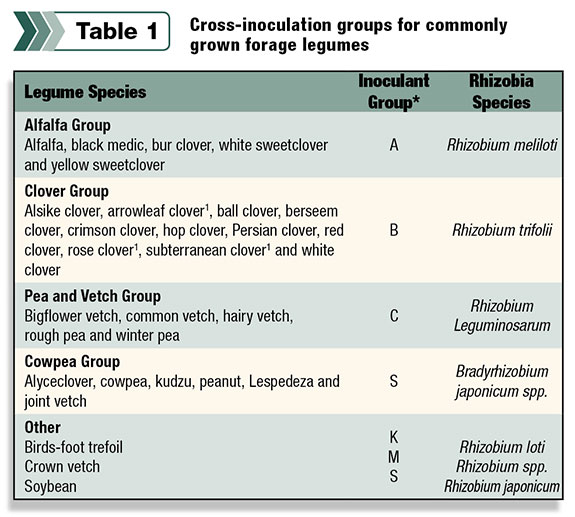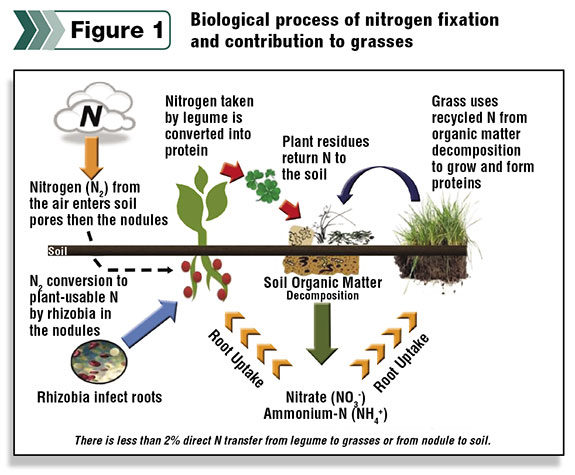They can have a symbiotic host for rhizobia bacteria which can fix nitrogen (N) from the air and convert it into a form plants can use.
These rhizobia bacteria enter into a close association with legumes by forming specialized structures referred to as nodules on the legume roots.
Although the N fixed by rhizobia is not directly available to grasses, legumes can increase nutrient cycling, especially N, within the pasture system and can decrease the need for application of N fertilizers.
Some of the benefits obtained from inoculating legumes include yield increase from 10 to 60 percent depending on soil conditions (soil fertility, soil pH, moisture, temperature); improved forage quality by increasing protein content and digestibility (protein concentrations tend to be between 12 to 28 percent in legumes compared with concentrations of 8 to 18 percent in well-fertilized grasses); and increasing soil nitrogen for grasses (a 30 to 50 percent legume stand in a grass field could add up to 80 to 150 lbs N per acre per year if the legumes are well-nodulated and fixing N – keep in mind that nitrogen fixation will vary depending on legume species and soil factors).
Soils contain millions of bacteria, but rhizobia bacteria proliferate best in soils planted with the correct host legume crop.
Rhizobia do live independently and carry over year-to-year in some soils, but the bacteria are not distributed evenly throughout the soil and the population numbers can be very low.
Rhizobia survive best in soils with lots of organic matter and live roots. Heavy clay soils with low or no organic matter are among the worst for rhizobia. Especially in dry, hot soil conditions, rhizobia survival season to season can be low.
Successful formation of nodules requires inoculation of the legume seed with the appropriate bacteria at planting and placing the seed in the soil in contact with the inoculant.
Many nodule-producing bacteria may be present in soils; however, all are not equally effective in fixing N. To ensure nodules will be formed from the best bacteria, it is important to inoculate legume seed before planting.
This may be critical to the success of forage legumes, especially in fields where the legume to be seeded has not been recently grown.
For infection and N fixation to occur, inoculant bacteria must be correct for the legume on which they are used, in contact with roots of the legumes they are to nodulate and alive and capable of infection.
It is also important to have adequate soil fertility. A medium to high soil test phosphorus and potassium level and pH of at least 6.0 are required for good nodulation to occur.
Some forage legume seed is sold as uncoated. The correct rhizobia inoculant must be purchased and applied before planting uncoated seed to ensure the legume plants will fix nitrogen.
The inoculant must be applied by the grower before the legume seed is planted. To obtain best results the following guidelines are recommended:
• Using the correct inoculant
An inoculant is a commercial product, often (but not always) mixed with a powdered peat base, used to introduce millions of live rhizobia into soils.
Because they contain live organisms, inoculants must be treated with care. Many types of soil rhizobia bacteria can form nodules on legume roots.
Different legume types have different root nodule shapes and sizes because each legume associates with a specific type of rhizobia.
Several species of legumes may be inoculated by one type of bacteria. These are called cross-inoculation groups. In some cases, only one species of legume may be in a cross-inoculation group.

Legume inoculants are divided on groups based on their capability of infection and N-fixation potential (Table 1).
In rare cases, if the wrong type of rhizobia comes in contact with the roots, the legume will form white or brown nodules that do not fix N.
It is important to check the inoculant package bale for the desired legumes species.
If the species is not listed on the package, do not use it.
• Inoculant bacteria should be alive
When buying inoculant, pay attention to the date on the package and how the inoculant has been stored.
After that date it is most likely that the bacteria might be dead.
Each package should have an expiration date. Even when the expiration date is still good, many bacteria might be dead if stored in environments with high temperature and high humidity, such as warehouses.
Leaving the inoculant package on the dashboard of a vehicle for a short period of time may also kill the bacteria. Rhizobia are quickly affected by temperature in dry conditions.
The best condition for storage is a refrigerator and not a freezer. Never store the inoculant below 40 degrees F or above 90 degrees F.
Avoid exposing inoculant or inoculated seeds to sunlight or ultraviolet light for a prolonged period of time. It is also important to avoid tearing holes in the package. Holes can cause desiccation of the peat and the bacteria.
• Using pre-inoculated seeds
Most commercially available legume species might have been pre-inoculated with bacteria using a peat or limestone coating or other available coating materials.
This process allows the sticking of a large number of bacteria to the seed prior to bagging for sale. Although bacteria on pre-inoculated seed can die in storage over time, some new present coating could extend the shelf life beyond a year if seed is properly stored.
It is advisable to check the tag and avoid purchasing seed when the expiration date has passed.
Do not get caught up on cheap seed and later pay for what you thought was cheap. Some inoculants or pre-inoculated seed may be sold with combinations of molybdenum (Mo) and a fungicide.
These additional treatments tend to reduce the number of live rhizobia and generally are not recommended.
How to inoculate uncoated seed
1. Use a commercial adhesive (sticking agent) or make one by diluting syrup or molasses with water. Use nine parts of water to one part of syrup, mix and shake well.
Make a corn syrup or sugar solution (a 1:4 solution of corn syrup and cool water) by mixing one cup (8 oz.) corn syrup with one quart (32 oz.) water for 50 pounds of seed.
2. Add enough sticking solution to moisten the 25 pounds of seed and mix thoroughly, coating every seed with the sticker. Do not apply too much sticking solution or seed will stick together and will be hard to plant. Add half the bag of the inoculant and mix thoroughly.
3. Use 5 oz. (about half a cup) of dry inoculum to treat 50 pounds of seed. Add ¼ cup of the dry inoculum to the syrup solution and mix to make slurry. (The remaining ¼ cup of inoculum will be used later).
Place the legume seed in a tub or cement mixer (paddles removed) and add the slurry. Mix until all seeds are coated.
Add the remaining ¼ cup of inoculant and allow the seed to dry in cool shade. Wet, sticky seeds can clog the planter.
Adding more inoculant or finely ground limestone speeds the drying process. The seed must be dry to flow properly through the planter.
Calibrate the seeder with inoculated seed when setting desired seeding rate. It is not possible to have too much inoculant. The above recipe makes enough sticking agent to treat 50 pounds of seed.
To make enough sticking agent for 100 pounds of seed, double the quantities. Use one cup of dry inoculum (8 oz.), two cups of corn syrup and two quarts of water.
Caution: Do not use carbonated drinks (Coke, Pepsi or any soda products) to stick the inoculant to the seed. The acidity (pH near 2.0) in soft drinks kills rhizobia.
Water is not a good sticker because the inoculant detaches as the water dries. Do not mix inoculated seed or inoculum with any fertilizer. Direct contact with fertilizers will kill rhizobia.
4. Plant the seed after inoculation (within 24 hours). If you cannot plant immediately, place the seed in a cool, dark place. It is advisable to re-inoculate the seed if not planted within 24 hours. Slightly moist soil will provide the best conditions for bacterial survival.
5. The inoculum in the coating on old (last season’s) seed has only a 50 percent chance of having enough live rhizobia to effectively nodulate the legume.
If a producer is uncertain about the storage conditions or past handling of pre-inoculated seed, adding fresh powdered inoculant will help ensure good nodulation. To re-inoculate, stick the fresh powdered inoculant to pre-inoculated seed without dissolving the coating by using mineral or vegetable oil as a sticker.
Do not use motor oil and petroleum products because they are toxic to rhizobia. Do not use water, sugar solution or carbonated drinks because they will dissolve the coating before planting, causing the seed to stick together and clog up the planter.
Mix the seed with mineral or vegetable oil (a half-ounce of oil per pound of seed. For example, use 12 ounces of oil for 25 pounds of seed).
Once the seed have a thin coating of oil, dust with the correct peat-based inoculum. Plant as soon as possible within 24 hours after applying the fresh inoculant.
Inoculation of legumes with the appropriate rhizobia bacteria is needed to maximize biological nitrogen fixation. The relative cost of inoculants is relatively cheap compared to nitrogen fertilizers, which makes the use of legumes a wise investment in forage production and management.
There are several important principles to remember when inoculating legumes: select the rhizobia inoculant or mixture of inoculants based on the legume species that will be planted, check the expiration date, correctly apply the inoculant to the seed and plant under favorable conditions in which plants are more likely to become nodulated and persist beyond the establishment year.
Never mix the inoculant with any kind of fertilizer or pesticide unless specifically labeled for that use; avoid contact with agricultural lime and plant seed within 24 hours after mixing with inoculant or re-inoculate. FG
—Excerpts from Mississippi State University Extension Service Forage News, September 2012
Rocky Lemus
Extension Forage Specialist
Mississippi State University












